The premise is simple: read one comic every day for the entire year. It seems like a simple task but there is no way that I read 365 comics last year, even if you count the individual issues in collections. So, this year, I am committing myself to this reading challenge, in the hope that I can broaden my reading habits and fully engage with my favorite hobby again.
My reading this week took a turn to the macabre because of my first read, Coffin Bound (volume 2). I’ve had the book sitting in my reading pile since last November, but always seemed to find other things to read and haven’t got around to picking it up until this week.
Now, that’s a part of this hobby I find fascinating. Almost everybody I know who buys, collects, and/or reads comics has a pile of stuff that they have bought but not gotten around to reading. Titles capture our interest and we have to have them but we don’t read them the minute we get them home. I could understand the attitude with novels, because they take more of a commitment to read, but most single issue comics can be read (at least initially) in 30 minutes at most. And yet our “read piles” keep growing.
Personally, I do this because I am not always in the right mood to read something in particular, but I also know what kind of comics I do like to read. For example, the first volume of Dan Watters and Dani’s Coffin Bound was outstanding. I loved the art and the deeply philosophical story, so I knew I had to get the second volume when I saw it, especially as it was at a convention where Dan Watters was signing. However, if I had not bought it at that moment, I would probably never have got around to buying it. My list of wants far outstrips my finances. So my comic buying becomes a kind of happenstance and those that I buy then have to wait patiently until I am in the right mood to read them.
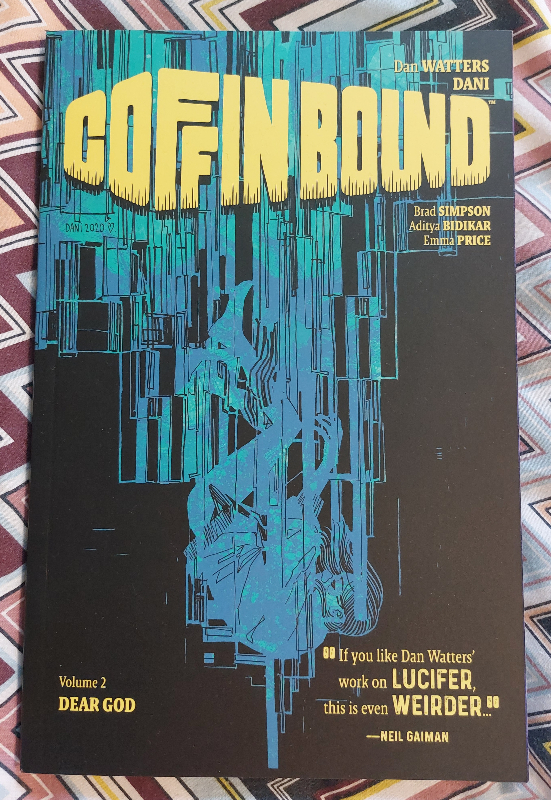
Credit: Image Comics
Comic Number 155: Coffin Bound volume 2 (Chapters 1 and 2)
If you haven’t read Coffin Bound, I highly recommend it. It’s extremely entertaining, has a surreal sense of humor, and waxes lyrical with the script and the art. This second volume revolves around Taga’s search for the Vulture, a mythical creature whose existence would also prove the existence of God, thus making it impossible for the state to pass legislation banning religion. Taga can hear the voice of God when she injects herself with a drug (named God) and she believes that the only way to draw the Vulture out is to put out an open contract on her own life.
It is a crazy ride, but Watters’ script is outstanding at holding all of the ludicrous ideas together in such a way that it all makes perfect sense. The characters are believable and likable, and the narrative is packed with humor and musings on the grander things in life. Watters plays with high concepts and forces the reader to look at them in a different light by presenting them in a new way: God as a literal drug allows the writer to explore the idea of religion, addiction, and how faith relates to both.
The artwork throughout this series is mind blowing. Dani switches the line work between precise cartooning and abstract shapes, and this creates a world of complexity, reflective of the script. The characters are instantly recognizable on the page which is a great achievement considering some of the outlandish turns the artwork takes.
Coffin Bound is a brilliant example of a creative team pooling their best work to create something that is far greater than the sum of its parts. The comic would not work without the atmospheric, moody colors by Brad Simpson, or the character-driven lettering of Aditya Bidikar. Even the design work by Emma Price helps to make this comic the superb read that it is. I think I would need many more hours and thousands of more words to really talk about Coffin Bound.
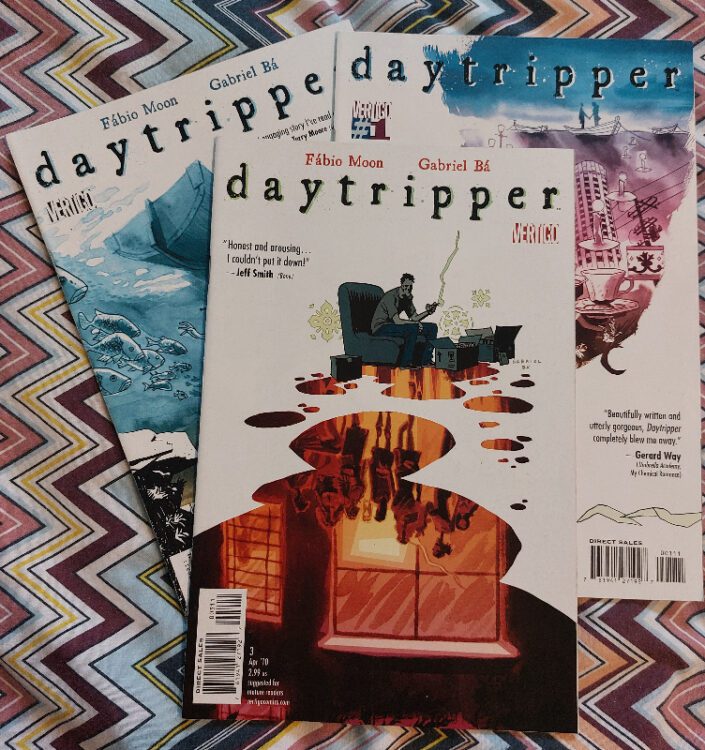
Credit: DC Vertigo
Comic Number 156 – 158: Daytripper #1 -10
Daytripper in another outstanding comic, this one published by DC’s Vertigo imprint in 2010. The creators, Gabriel Bá and Fábio Moon produced a series that played with a notion that is intrinsically comic book: the recurring death of the same character. Each issue of the series focuses on a different period of Bras’ life and the final page of each issue contains a short obituary explaining how he died in that particular period. The next issue then picks up at a different point in his life, with Bras alive and well, even though this chapter might be in the past or the future. Bá and Moon kill off their central character in every issue.
But despite the fact that the comic is about death, about that final moment when Bras ceased to be, the series is actually a celebration of life. The death’s become metaphors of the evolution of Bras and the life he leads. At each age depicted in the comic, Bras reaches a turning point, an experience that deeply affects him and, in essence, a part of him dies but his life continues.
Although I have read all ten issues, I have picked three out worth mentioning separately.

Credit: DC Vertigo
Issue 3 sees Bras breaking up with his longtime partner at the age of 28. The relationship had become stagnant because of the normality of life and Bras dwells on the final argument that they had. The artwork throughout this issue captures that feeling of loss perfectly. There are panels that have an emptiness to them, even though characters and props are present. Dave Stewart’s coloring helps to create this effect, with Bras physically and emotionally separated from the world around him. And the change of atmosphere towards the end of the comic is subtle and delicate. The issue takes the reader through the emotional journey of a breakup, and just like life, out the other side in such a way that you barely notice the change.
Issue 4 is, at this point in the series, the most upsetting. By this issue you understand the pattern the narrative takes and the inevitable death that Bras will face at the end of the comic, so the cover depicting Bras as a child immediately grabs you. Chapter 5 is about an eleven year old Bras, his family weekends away at his grandparents, and his first kiss. It is a heartwarming story told with such joy and excitement. The artwork captures the childlike excitement for the world and elevates everything to the sphere of adventure. Memories of your own childhood will come flooding back as you identify with the essence of the age, if not the actual events.
Of course, we all know where this is ultimately going but the ending is still shocking. It’s a punch in the stomach and a knife right through the heart. Fábio Moon and Gabriel Bá seem intent on breaking their readers’ hearts, and this issue is almost the pinnacle of that goal.
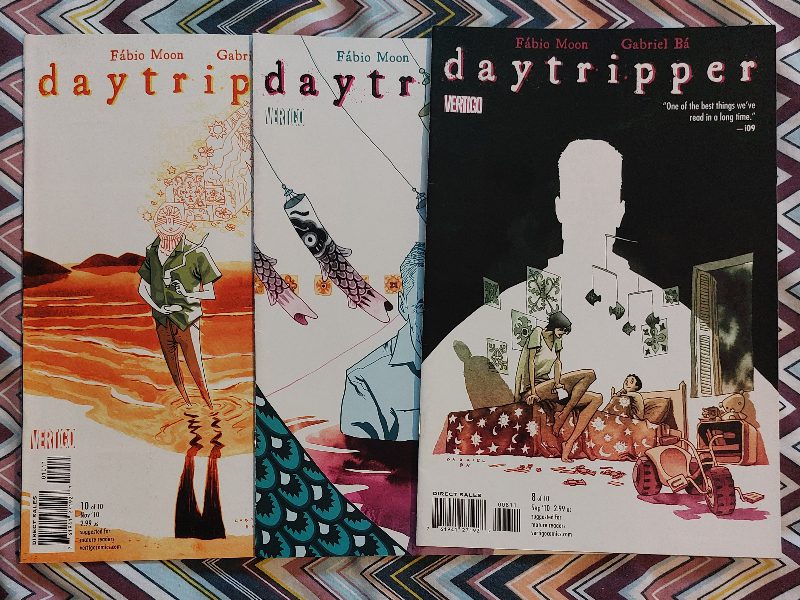
Credit: DC Vertigo
Issue 8 is a little different to the others because it features Bras’ family and he is off panel for the entire issue. The narrative here is about how interconnected people’s lives become and, ultimately, about those we leave behind. If you thought issue 4 was a heart-breaker you’ll not be ready for this one. The absence of the central character is ever present and the emotional connection that the writer and artist create between his family and the reader is overpowering as a result. There is a moment in this comic that is actually a visual representation of my worst nightmare, as a parent. The Young Miguel stands in front of his classmates on the day his father is supposed to talk about his career and the expression on his face says it all, and is almost too much to bear.
From issue 1 to issue 10, Daytripper is a magnificent read; Powerful, emotional, and heartbreaking. But ultimately it is the story of a life worth living.
“Only when you accept that one day you’ll die can you let go and make the best out of life.”

Credit: Marvel Comics
Comic Number 159: Punisher #12
Superheroes die all the time. And they always come back. One of the biggest complaints about any comic that features the death of a superhero is that no one believes the death will last. The best way to handle such stories is to openly, through the narrative, admit that the character isn’t dead, like Jonathan Hickman killing Johnny Storm in the Fantastic Four. The death was to illustrate the effect it would have on the rest of the team, not on creating a sensational headline to sucker readers. Unfortunately, I don’t think Marvel PR got that memo.
Another example is the recent “death” of the Punisher in issue 12 of Jason Aaron’s recent run. CBR ran a story with the headline “Marvel confirms ‘the Punisher is no more’” leading people to think that Marvel have killed the character. I saw a number of tweets and Facebook posts outraged at the publisher for doing away with a fan favorite. But, unlike the recent killing of Kamala Kahn, they don’t even kill Frank Castle, not even for a moment, in the comic. The CDR article even says that the character survives. Unfortunately, there are a number of people who only read headlines and then react, or more precisely, overreact, to the news.
I read Punisher number 12 to see what the fuss was all about. (Do you see? The false outrage worked.) There are some great things in this comic — for example, the change in art style between the modern day story and the flashback sequences, and the questions Aaron raises about the morality of Castle’s actions. However, there is also a lot here that a) doesn’t interest me (I always find it disappointing when the Punisher becomes a part of the superhero world but that’s personal preference), and b) is a cop out. I enjoy Aaron’s work, but under the Marvel umbrella, I think that writers can become restricted in what they can do, especially as they reach the end of their run. The characters have to return, or be able to return, to a reset point for the next creative team. This can undermine a lot of the work that the current team has put into their narrative. Personally, I think the creative team should just bail on a high and let the next lot sort it out. Jonathan Hickman’s Avengers run would have been perfect if it had ended with issue 1 of Secret Wars where he killed everything (nearly) instead of the dire 9 issue run where a series wide reset had to be worked out. Again, that’s just my personal opinion.
Anyway, I think Punisher issue 12 is probably a good ending to the series, and if you’ve been reading it, it will feel like a satisfying conclusion. But this comic is not about killing a hero, it’s about the transition from one story to another, in much the same way that the deaths of the central character in Daytripper were metaphors for the stages of his life.
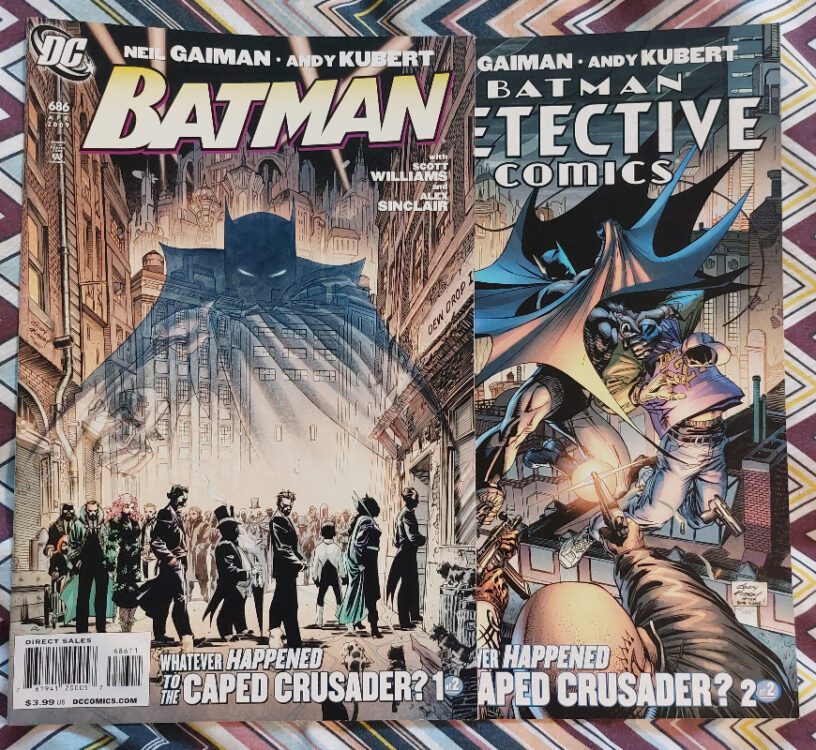
Credit: DC
Comic Number 160: Batman #686 and Detective Comics #853
One way to look at the history of a character is through a final story — a last swan song before the character dies. Grant Morrison and Frank Quitely used the premise to great success on All-Star Superman and Alan Moore also had a hit on his hands with another final Superman story, Whatever Happened to the Man of Tomorrow.
In 2009 Neil Gaiman wrote a similar story for DC entitled Whatever Happened to the Caped Crusader. Illustrated by Andy Kubert, the story revolved around a wake for the Gotham vigilante that was held in the back room of a pub. Friends and foes turn up to mourn the death of Batman and take turns to tell the story of how he died. Each story is different and takes in the history of the character, illustrating the various incarnations of Batman and those he fought. Gaiman’s deft narrative layers history, myth, and comic book clichés as a way of dissecting the character and his history in pop culture. The wild shifts between the art and narrative styles are reflected in the different stories the various characters tell. This is most prominent in the Catwoman tale as she alters appearance from panel to panel, showcasing her wide ranging history.
There is, obviously, something else going on behind the scenes and the big reveal isn’t as corny as it could have been. Although, in the hands of a writer like Neil Gaiman, even the most clichéd narrative can seem like poetry. As a stand-alone Batman story, Whatever Happened to the Caped Crusader is a joyful exploration of the character and evolution of stories, especially through comic books. The finality of death once again acts as a catalyst for the examination of life.
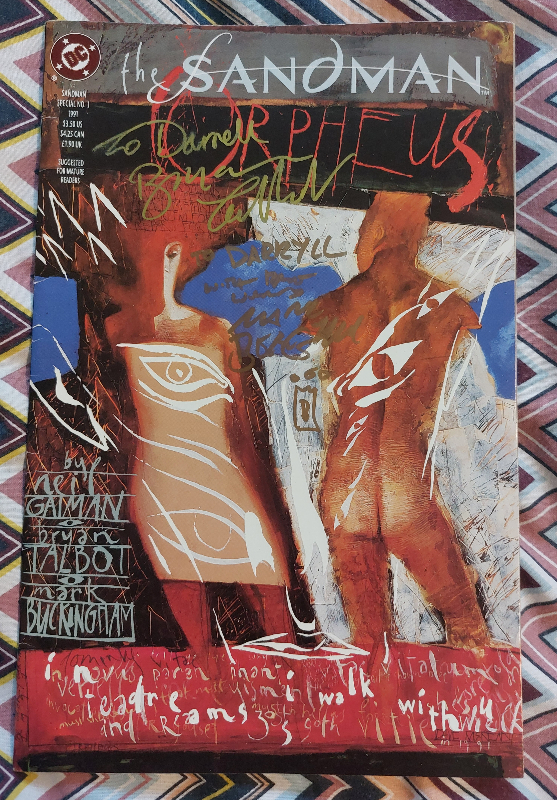
Credit: DC Vertigo
Comic Number 161: The Sandman Special #1: Orpheus
I don’t have much to say about this comic, at the moment. It is one of my favorite comics of all time, written by one of my favorite writers. The blending of mythology with modern comics lore is expertly handled and the artwork by Bryan Talbot and Mark Buckingham is majestic.
The overwhelming theme of death that has featured in my reads this week is exemplified in Orpheus. Death, the rejection of that death, and the fight to overcome and reverse death, leans heavily into the main themes of ancient myths and the greater story in Gaiman’s Sandman comic. One fate that we all share is that we will one day die. How we deal with that, and how we live our lives, will ultimately shape our history. Orpheus stands out from many of the characters featured in this week’s reading because he cannot accept the death of his wife and, in the end, suffers eternally by losing the ability to die himself. Whereas previous comics have been about the life lived before death, This Sandman Special is about the life wasted fighting against the inevitable.
It is a beautiful story, brilliantly crafted, and stands as a reminder to embrace life and suffer things that we can’t change.


